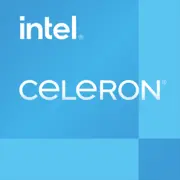Intel Celeron 3215U

インテル セレロン 3215U: 2025年の基本的なタスク向け予算プロセッサ
10年のアーキテクチャの可能性と関連性の分析
アーキテクチャとプロセス技術: ブロードウェルの遺産
2015年に発売されたインテル セレロン 3215Uは、インテルコアの第5世代であるブロードウェルマイクロアーキテクチャに基づいています。これは、同社が10nmプロセスに移行する前の最後のラインの1つですが、セレロン3215Uは14nm規格で製造されています。主な特徴:
- 2コアと2スレッド: ハイパースレッディングを欠いているため、マルチタスク性能が制限されます。
- 基本クロック1.7GHz: ターボモードはサポートされておらず、これは予算モデルのセレロンには典型的です。
- 内蔵グラフィックス Intel HD Graphics (ブロードウェル GT1): 12の実行ユニット、周波数850MHzまで。画像の出力や簡単なタスク(動画視聴など)にのみ適しています。
ブロードウェルアーキテクチャは、ハズウェルに比べてエネルギー効率を改善しましたが、2015年当時でもセレロン3215Uは「ベーシック」な選択肢と見なされていました。2025年には、ビッグ・リトルのコア(ARMのような)やAMD Ryzen 3の7nmチップと比べると、その能力は時代遅れに見えます。
消費電力とTDP: ウルトラポータブルデバイス向けの15W
TDP 15Wは、アクティブ冷却なしで薄型ノートパソコンやクロームブックでプロセッサを使用できることを可能にします。しかし、実際には、ほとんどのCeleron 3215U搭載デバイスは予算定位のため、控えめなヒートシンクとファンが装備されています。
低TDPの利点:
- 最小限の加熱。
- コンパクトな筐体の作成が可能。
- パッシブ冷却システムとの互換性(珍しいですが、一部のウルトラブックに見られます)。
欠点:
- エネルギー効率を重視するあまり性能が犠牲にされます。
性能: 2025年の現実
Geekbench 6のテスト結果(シングルスレッド332点、マルチスレッド587点)は、Celeron 3215Uが現代の予算プロセッサにさえ後れを取っていることを示しています。
オフィスタスク
- Microsoft Office、Google Docs: 文書の作業は可能ですが、同時に10以上のタブをブラウザで開くと遅延が発生します。
- Zoom/Teams: HD解像度でのビデオ通話はCPUを80-90%負荷しますが、ラグが発生する可能性があります。
マルチメディア
- YouTube/Netflix: 1080p(ハードウェアアクセラレーション経由)での動画再生は安定しています。
- 写真編集: LightroomやGIMPでの基本的な修正は可能ですが、レンダリングにはPentium Gold 2023年モデルの2-3倍の時間がかかります。
ゲーム
- 内蔵グラフィックス: ゲームの起動は2010年までのプロジェクト(例: Half-Life 2)に限られ、低設定での実行です。2025年のMinecraftでも20-25FPSでしか動作しません。
使用シナリオ: Celeron 3215Uは誰に向いているか?
このプロセッサは以下のようなユーザーに適しています。
1. 学生: 講義や文書作成に使う安価なノートパソコンを必要とする人。
2. 高齢者: Skype、メール、ニュース閲覧のためにデバイスを使用する人。
3. セカンダリーデバイス: 例えば、レシピ用の「キッチン」ノートパソコン。
注意: 以下のような場合にはCeleron 3215Uは検討しないでください。
- グラフィックやビデオ編集を行う。
- ノートパソコンを3年以上使用する予定。
- 現代のゲームをプレイする。
バッテリー性能: 理想的な条件下で最大8時間
バッテリー容量が40-45Whのノートパソコンは、Celeron 3215U搭載で以下の実績を示しています。
- ウェブサーフィンで6-8時間。
- 動画視聴で4-5時間。
省エネルギー技術:
- インテル スピードステップ — ダイナミックなクロック変更。
- C状態 — 使用されていないコアを無効にします。
ただし、インテルスレッドディレクターのような現代技術がないため、負荷管理の効率が低下しています。
競合との比較: Celeron 3215Uの代わりに何を買うべきか?
2025年の予算セグメントでも、Celeron 3215Uは競合に劣っています。
1. AMD Athlon Silver 7120U (2023): 2コア/2スレッド、TDP 15Wですが、Zen 2アーキテクチャとRadeon Graphicsによりパフォーマンスが40%向上(ノートパソコン価格: $300-$400)。
2. Intel Processor N200 (2023): 4コア/4スレッド、TDP 6W、Wi-Fi 6をサポート(ノートパソコン価格: $280から)。
3. Apple M1 (2020): 中古のMacBook Airではパフォーマンスが2倍以上、バッテリー持続時間は18時間(中古価格: $400、現在は新モデルは生産されていません)。
Celeron 3215Uの長所と短所
強み:
- ノートパソコンの低価格($250-$350)。
- 基本的なタスクには十分。
- コンパクトで軽量な筐体。
弱み:
- 古いアーキテクチャ。
- 将来的なソフトウェア更新の余力がない。
- 弱いグラフィックス。
ノートパソコン選びの推奨事項
Celeron 3215U搭載のデバイスを購入することにした場合、以下に注意してください:
- ストレージタイプ: SSDのみ(最低でも128GB)。HDDではシステムが応答しなくなります。
- RAM: 最低でも8GBを必須としています。2025年では4GBではChromeすら不足です。
- 画面: フルHD解像度がHD(1366x768)より好ましいですが、滅多に見かけません。
- ポート:
基本
CPUの仕様
メモリ仕様
GPUの仕様
その他
ベンチマーク
他のCPUとの比較
ソーシャルメディアで共有する
または当サイトへのリンクを追加
<a href="https://cputronic.com/ja/cpu/intel-celeron-3215u" target="_blank">Intel Celeron 3215U</a>